 Originally posted by yeatzee
Originally posted by yeatzee 
....
Contrary to common belief adding glass can in fact improve image quality, this being a case in point. The image quality is actually better when stacking these two lenses than if I were to reverse the 28mm on enough extension tubes to equal the same amount of magnification........:
I hope it is appropriate to discuss technique/theory rather than posting photos here.
What you say about reversed stacked lenses being better than either lens by itself makes good sense in theory I think.
I base what I say largely on conjecture rather than direct knowledge of real camera lens design although I've seen good support of that conjecture in what I've read.
The basic idea is that lenses for normal (ie. low magnification) use are designed such that a far away subject yields a good image at the sensor. For example, I have read that it is common for lenses to be optimized for operation at the hyperfocal distance.
The key principle is that since light doesn't know which direction it is traveling trough a lens, light shined backwards from a lens' image plane exits the front of the lens bound for focus at a far-away subject plane.
When lenses are reversed and stacked, light from the subject (corresponding to the image plane of the first lens in the chain) exits the lens as though it were coming from a far away subject. The second lens in the chain therefore receives the light it was designed for and can create an optimum image.
Doubling the number of optical surfaces might lead to extra flare, but that is an entirely different aspect of lens performance and does not alter the earlier conclusion. A reversed lens pair could have good flatness and resolution while losing contrast due to flare.
A first guess is that the best aperture for the combined lenses would be that each lens should be set at its own best aperture; this could be easily tested in practice (HINT) and is consistent with Yeatzee's observations.
I look forward to comments.
Dave
PS I think counter arguments based on overall magnification may be valid; ie the optimal performance for a lens assumes the image plane is close to the lens' focal distance.
However a reversed stack of identical lenses must exactly compensate for each other at 1:1 magnification; at 1:1 magnification what originates at the subject plane must be exactly that received at the image plane due to the stack's symmetry (even for bad lenses in principle).
For completeness:
Yeatzee's stacked lenses had an effective focal length of about (I'll assume a spacing of about 5mm between front focal distances) of:
f ~ 135*28/(135 + 28 +5) = 22.5mm.
Therefore the overall f-number of the combination was a factor of 22.5/28 (about 80%) of that set on the 28mm lens barrel.
Last edited by newarts; 05-08-2011 at 05:15 AM.


 Similar Threads
Similar Threads 



 This club is meant to be as informative as it is entertaining for you guys
This club is meant to be as informative as it is entertaining for you guys 






 can't wait to compare it to my favorite m 50mm f/1.7 reversed
can't wait to compare it to my favorite m 50mm f/1.7 reversed  ) what I said is based off of my own experience and the wonderful photomacrography forum I am a part of.
) what I said is based off of my own experience and the wonderful photomacrography forum I am a part of. 





 Post #399 by Audi 5 cyl
Post #399 by Audi 5 cyl








